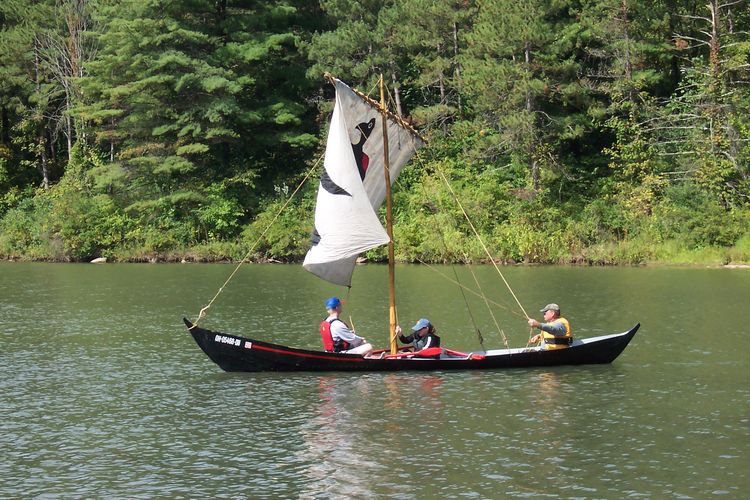Late Viking Age Ship Terminology
originally posted to the Viking Age Vessels email group
From Ships & Men in the Late Viking Age, by Judith Jesch, a book which studies the runestone corpus and skaldic verse from the latter half of the Viking age (there’s not much earlier material), to determine what terminology was actually used then.
Skip and skeið are the most common terms for ship, skip being used in many contexts showing it did not refer to any particular type or use of ship. Skeið, on the other hand, is almost always used of a ship “either on the way to or in the thick of battle and clearly connotes a warship”. Langskip (longship), despite its common use in the sagas written down post-Viking-age, means any ship that is long, i.e. not not necessarily a warship and “is not a technical term”. “The most common compound with skip is herskip ‘warship’”
Dreki (pl. drekkar) (‘dragon’), derived from the dragon heads on the prow (and sometimes also on the stern). It is used primarily as poetic metaphor for a ship, and “there is no evidence that it was a technical term for any particular type of ship”.
Jesch confirms that knorr is more often used for a ship of trade, but notes the many places where it refers to a ship used for war. She quotes Ole Crumlin-Pedersen (1997a, 189-90 [does anyone have a copy of this?]) “that the relative beam of ships ‘changed drastically in the early phase of the process of adapting ships to carry sail, in order to provide sufficient stability at the initial stage’”. Thus, since early Viking warships such as Tune and Gokstad [anyone have length-to-beam ratios for these?] had similar proportions to cargo ships, and later ones were more slender, early overlap of knorr and terms for warship giving way to a later (late- or post-Viking) distinction is consistent with shipbuilding practice.

Anchors are mentioned several times in the skaldic corpus, perhaps explained by [lacuna]. Crumlin-Pedersen (1997b, 146) makes the point that anchors are ‘the largest examples of forged ironwork’ known from the Viking Age and that, because of their cost, they were used only on the largest ships.” So, perhaps having an iron anchor on our boats would be a sign of their high quality.
The skaldic corpus also provides evidence of slipways using simple log rollers to beach ships during the Viking Age. This and the references to harbors (and the pilings at the trading center on Lake Malar), suggest the Vikings only hauled their ships up on an undeveloped beach when they had to.
Styrimaðr (lit. ‘steersman’) is usually taken to mean captain, often captain-owner, and can also be used like a title. Sometimes it helps commemorate the sailing skills of a man, without implying command.
Skipari (pl. skipan) is the root of the modern Scandinavian and English ‘skipper’, but the author finds its use in the Viking Age to more often make sense as a crew member. This would be especially true of the plural skipan. Sometimes it appears to be an officer subordinate to a Styrimaðr.
Motunautr (pl. motunautar), ‘mess-mate’ also appears in nautical contexts.
Sogn and Sókn (etymologically a ‘seeking’ -> attack or battle) can refer to any assemblage of people; in a nautical context this means a ship’s crew.
Sessi, derived from sess, rowing-bench, means ‘bench-mate’, either in the hall or on a ship.
Lið has a wide range of meanings, basically a group of people, “in most cases it can be translated as ‘troop’”. Sometimes, by extension, it means ‘fleet’. It occurs in many compounds. Skiplið is often taken to mean crew who will or must man a ship (as Ragnar used in the Fydraka Skiplið magnets); the author finds that in many cases ‘collection of ships’ makes inscriptions make more sense. Thingalið is much discussed by scholars, but a straightforward compound of Thing and lið should be Thinglið. Most scholars take it to refer to the retainers of a great man, but Jesch finds more sense translating it as ‘contracted troop’ from the sense of thing in which it means ‘battle’. Liðsmenn are troops strongly associated with a ship or fleet.
Floti refers to a large fleet, which it will take us some time to assemble. :-) Sometimes it can also refer to the crew of the fleet as well.
In medieval Scandinavia, leiðangr refers to the royal levy of men and ships, but the Viking age evidence does not confirm any meaning more specific than ‘fleet’. Thus, the question of when the levy system came into use must rest on other evidence.
As always, while we strive to improve our understanding, we should always remember that many interpretations of the evidence is available and be courteous about suggesting different word usage.
So, may I suggest to my bench-mates that we are the Vestrus skipan?